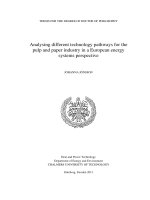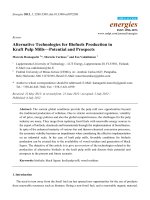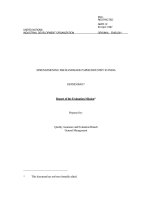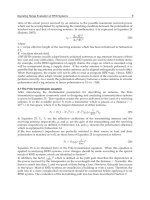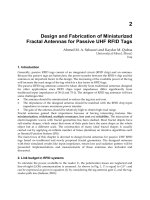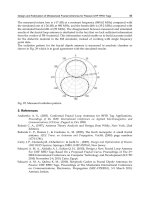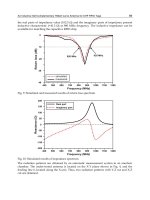MARKET OPPORTUNITIES FOR PAPER INDUSTRY IN RADIO FREQUENCY IDENTIFICATION pot
Bạn đang xem bản rút gọn của tài liệu. Xem và tải ngay bản đầy đủ của tài liệu tại đây (429.47 KB, 109 trang )
Technology Business Research Center
Research Reports 20
MARKET OPPORTUNITIES FOR PAPER INDUSTRY IN
RADIO FREQUENCY IDENTIFICATION
Matti Lehtovaara, Matti Karvonen, Kimmo Suojapelto and Tuomo Kässi
Technology Business Research Center Lappeenranta
Lappeenranta University of Technology
P.O.BOX 20, FIN-53851 LAPPEENRANTA, FINLAND
/>
Lappeenranta 2009
ISBN 978-952-214-714-1 (paperback)
ISSN 1795-6102
ISBN 978-952-214-715-8 (PDF) (URL: />
Digipaino, Lappeenranta, 2009
ABSTRACT
Matti Lehtovaara, Matti Karvonen, Kimmo Suojapelto, Tuomo Kässi
Market Opportunities for Paper Industry in Radio Frequency Identification
Research Report
Lappeenranta 2009
97 Pages, 31 Figures, 16 Tables, 1 Appendix
The paper industry has been experiencing remarkable structural changes since paper
demand growth has ceased and some markets are declining. One reason behind the declined demand is the Internet, which has partially substituted the newspaper as a source
of information. Paper products alone can no longer provide livelihood, and the paper
industry has to find new business areas.
In this research, we studied radio frequency identification (RFID), and the market opportunities it could provide for paper industry. The research combined a quantitative
industry analysis and qualitative interviews. RFID is a growing industry in the beginning of its life cycle, in which value chains and technologies still evolve significantly.
The industry is going to concentrate on the future, and in the long term RFID-identifiers
will probably be printed on paper substrate or directly onto products.
Paper industry has the chance to enter the RFID industry, but it has to obtain the required competences, for example through acquisitions. The business potential RFID
offers to paper industry is inadequate, and while reviewing new strategic options, the
paper industry must consider more options, for example the entire printed intelligence.
Keywords: Radio frequency identification, printed intelligence, value chain, paper industry
TIIVISTELMÄ
Matti Lehtovaara, Matti Karvonen, Kimmo Suojapelto, Tuomo Kässi
Paperiteollisuuden Mahdollisuudet Radiotaajuisessa Etätunnistuksessa
Tutkimusraportti
Lappeenranta 2009
97 Sivua, 31 kuvaa, 16 taulukkoa, 1 liite
Paperiteollisuus on suuressa rakenteellisessa muutoksessa, sillä paperin kysynnän kasvu
on pysähtynyt tai jopa vähentynyt eräillä markkina-alueilla. Eräs tekijä vähentyneen
kysynnän taustalla on Internet, joka on osittain korvannut perinteiset lehdet informaation välittäjänä. Paperituotteet eivät enää yksin mahdollista elinkelpoista liiketoimintaa,
vaan paperiteollisuuden on löydettävä uusia liiketoiminta-alueita.
Tässä työssä tutkittiin radiotaajuista etätunnistusta (RFID) ja sen tarjoamia liiketoimintamahdollisuuksia paperiteollisuudelle. Tutkimuksessa yhdistettiin määrällinen toimiala-analyysi sekä laadullinen haastattelututkimus. RFID on elinkaarensa alkuvaiheessa
oleva kasvava toimiala, jonka arvoketjut ja teknologiat edelleen kehittyvät huomattavasti. Toimiala tulee tulevaisuudessa keskittymään, ja pitkällä aikavälillä RFID-tunnisteet
tullaan todennäköisesti painamaan joko paperitarralle tai suoraan lopputuotteeseen.
Paperiteollisuuden on mahdollista mennä RFID-toimialalle, mutta se edellyttää vaadittavien kyvykkyyksien hankkimista esimerkiksi yritysostoin. RFID-alan liiketoimintapotentiaali on niin ikään riittämätön paperiteollisuudelle, ja sen on tutkittava esimerkiksi
koko painettua älykkyyttä strategisia vaihtoehtoja mietittäessä.
Hakusanat: Radiotaajuinen etätunnistus, painettu älykkyys, arvoketju, paperiteollisuus
FOREWORD
This research report describes the findings of master’ thesis “
s
Market Opportunities for
Paper Industry in Radio Frequency Identification” that was carried out along with
Talikko research project. The research project Talikko at Technology Business Research Center (TBRC) in Lappeenranta University of Technology (LUT) studied new
business opportunities emerging in the intersections of forest-, ICT- and energy industries. During the research we realized the importance to understand the industry
changes, and to draw the appropriate conclusions. We hope that this report could be of
practical use both for industry representatives and academics.
We are grateful for everyone who supported to our research, and especially we like to
thank the interviewees who greatly contributed to our project. Finally, we thank our
researchers Matti Karvonen, Matti Lehtovaara and Kimmo Suojapelto. Many employees
from TBRC and LUT also lend us a hand when needed, and we owe warm thank you to
them.
In Lappeenranta, January 2009
Tuomo Kässi
TABLE OF CONTENTS
1
INTRODUCTION .......................................................................................................... 1
1.1
Background .......................................................................................................... 2
1.2
Objectives and limitations of the study ................................................................. 2
1.3
Structure of the research ....................................................................................... 4
2
IMPACTS OF ICT ON FOREST INDUSTRY ............................................................... 6
3
INNOVATIONS AND COMPETENCES..................................................................... 11
3.1
3.2
Enterprise competences ...................................................................................... 14
3.3
Industry trajectories ............................................................................................ 16
3.4
4
Towards open innovation.................................................................................... 11
Technology cycles .............................................................................................. 19
RESEARCH METHODS.............................................................................................. 21
4.1
4.2
Interviews of Finnish RFID specialists................................................................ 22
4.3
5
Industry analysis................................................................................................. 21
Research flow ..................................................................................................... 23
RFID AS PART OF PRINTED INTELLIGENCE ........................................................ 25
5.1
Printed intelligence ............................................................................................. 25
5.2
Radio frequency identification ............................................................................ 29
5.2.1
5.2.2
6
RFID technology and security issues.................................................... 30
RFID benefits, applications and markets .............................................. 33
RFID INDUSTRY ANALYSIS .................................................................................... 45
6.1
Value chain analysis ........................................................................................... 45
6.1.1
6.1.2
6.2
General industry analysis ..................................................................... 46
Comparative analysis of RFID players ................................................. 54
Typical key players............................................................................................. 65
6.2.1
6.2.2
Upstream focused firms........................................................................ 67
6.2.3
Downstream focused firms................................................................... 68
6.2.4
6.3
Vertically integrated firms.................................................................... 65
PPI and printing firms .......................................................................... 69
Expert views about industry development ........................................................... 71
6.4
7
Summary of the key issues ................................................................................. 74
FUTURE OPPORTUNITIES FOR PAPER INDUSTRY.............................................. 78
7.1
RFID benefits for paper industry......................................................................... 78
7.2
Visions for paper industry................................................................................... 80
7.2.1
7.2.2
8
Business as usual –Corporate A........................................................... 80
Green Gold –Corporate B.................................................................... 82
DISCUSSION............................................................................................................... 83
8.1
8.2
Reliability and validity of the results................................................................... 86
8.3
9
Results of the study ............................................................................................ 83
Limitations and possible further studies .............................................................. 87
CONCLUSIONS .......................................................................................................... 88
REFERENCES
APPENDICES
Appendix I List of TBRC Research Reports
LIST OF FIGURES
Figure 1: The general framework of the study ............................................................... 5
Figure 2: Paper consumption and GDP relation............................................................. 7
Figure 3: Paper and paperboard demand forecast through 2020..................................... 8
Figure 4: The open innovation model.......................................................................... 13
Figure 5: The interrelation between strategies and competences .................................. 15
Figure 6: Technology cycles ....................................................................................... 20
Figure 7: Research flow .............................................................................................. 24
Figure 8: Hybrid media triangle and overseas R&D projects ....................................... 27
Figure 9: Industries that need to collaborate ................................................................ 29
Figure 10: Total RFID market projections 2008-2018 ................................................. 35
Figure 11: RFID value chain ....................................................................................... 38
Figure 12: Typical characteristics of substrates ........................................................... 39
Figure 13: High volume item level RFID tagging........................................................ 41
Figure 14: RFID value chain ....................................................................................... 46
Figure 15: The age of all RFID firms .......................................................................... 48
Figure 16: The age of PPI and printing firms............................................................... 49
Figure 17: Industry classifications of all firms............................................................. 50
Figure 18: Industry classification of vertically integrated firms ................................... 51
Figure 19: Industrial classification of upstream focused firms ..................................... 52
Figure 20: Industry classification of downstream focused firms .................................. 53
Figure 21: Industrial classification of PPI and printing firms ....................................... 54
Figure 22: Average number of employees in 2007 ...................................................... 56
Figure 23: Average employee growth %, 5 years ........................................................ 57
Figure 24: Average revenue (MEUR) in 2007 ............................................................. 58
Figure 25: Average revenue growth %, 5 years ........................................................... 59
Figure 26: Average ROIC %, 5 years .......................................................................... 60
Figure 27: Average R&D expenditure (MEUR) in 2007.............................................. 61
Figure 28: Average R&D %, 5 years........................................................................... 62
Figure 29: Average EBIT (MEUR) in 2007................................................................. 63
Figure 30: Average EBIT growth %, 5 years............................................................... 64
Figure 31: RFID value chain development .................................................................. 77
LIST OF TABLES
Table 1: Five major technological trajectories ............................................................. 17
Table 2: Innovation activities in PPI and electronics industry...................................... 18
Table 3: Interviewee information ................................................................................ 23
Table 4: Different areas of printed functionality .......................................................... 26
Table 5: The characteristics bar code versus RFID ...................................................... 33
Table 6: Typical RFID application areas ..................................................................... 34
Table 7: RFID market development ............................................................................ 37
Table 8: Paper vs. plastic RFID tag substrate .............................................................. 40
Table 9: Electronic vs. optical codes ........................................................................... 42
Table 10: Printed vs. conventional RFID tag............................................................... 43
Table 11: Summary of the analysed firms ................................................................... 47
Table 12: Comparison between RFID firms ................................................................ 55
Table 13: RFID value chain development ................................................................... 73
Table 14: RFID market evolution, drivers and hindering factors.................................. 74
Table 15: RFID vs. barcodes, RFID tag substrates and technology.............................. 75
Table 16: RFID benefits for paper industry ................................................................. 79
ACRONYMS
B2B
Business to business
EBIT
Earnings before interest and taxes
EPC
Electronic product code
HF
High frequency
IC
Integrated circuit
ICT
Information and communication technology
ID
Identification
IP
Intellectual property
ISO
International organization for standardization
LF
Low frequency
NPD
New product development
PPI
Pulp and paper industry
R&D
Research and development
RFID
Radio frequency identification
ROIC
Return on invested capital
R2R
Roll to roll
SBU
Strategic business unit
SCM
Supply chain management
SIC
Standard industrial classification
SME
Small and medium size enterprise
STDEV
Standard deviation
UHF
Ultra high frequency
1
INTRODUCTION
During the most part of the past century paper consumption was strongly linked to economic growth of nations and the consumption increased rather steadily. However, it
seems that such direct connection between gross domestic production (GDP) and consumption is no longer valid. In fact, paper consumption began to decline in North
America during 1990’ and today, also the markets in Western Europe and Japan are
s
mature. (Hetemäki & Nilsson 2005)
One of the key reasons for the declined demand is that electronic media, especially
Internet, have rapidly substituted traditional media including newspapers, radio and
television as a source of information and news. This has lead to an overcapacity in
many paper product brands, falling end product prices and decreased profitability of
pulp and paper industry (PPI). (Hetemäki & Nilsson 2005)
The paper demand still increases in Asia, particularly in China, and the paper industry
has invested heavily into new manufacturing plants there, while closing production capacity in mature markets. In addition to these structural changes, the industry in Finland
is facing the challenges of high input costs and shortage of raw materials. In these circumstances there is a strong likelihood that the Finnish paper industry will make its further investments in the growing markets, where raw material and labor costs are also
competitive. The industry may wither away in Finland, a development that would have
deep consequences for many individuals as well as the whole society.
Paper products alone can no longer offer livelihood for the entire industry, and it is of
significant importance that the industry augments its efforts to generate new businesses.
Printed intelligence extends new functionalities typically into paper or plastic substrate
(e. g. Hakola et al. 2006; Södergård et al. 2007). Among other areas of printed intelligence, radio frequency identification (RFID), especially printed RFID, could offer new
business opportunities for the paper industry.
1
1.1
Background
Technology Business Research Center (TBRC) was founded in 1999, and it is an internationally operating research institute at Lappeenranta University of Technology (LUT).
TBRC’ competences are based on the university’ resources and strengths, in particular
s
s
technological and business knowledge. These dual resources enable the institute to build
multi-disciplinary teams, which are able to execute demanding research projects.
The Institute’ research strategy is to produce high-level academic results as well as
s
practical solutions for the industry, combining technology and business issues and taking international orientation into consideration. At present TBRC’ key customer induss
tries include forest-, ICT-, energy- and metal industries as well as the public sector.
Typically the implemented research projects are funded by both national and international financiers and industries. (TBRC 2008)
Due to eroding industry boundaries and the new, evolving business environment, novel
approaches are necessary in order to identify and exploit potential business opportunities at the intersection of industries. The primary objective of the Talikko research project was to identify new business opportunities emerging, particularly in the intersections of forest-, ICT- and energy industries. (Karvonen et al. 2008a)
This study was completed within a Talikko research project studying the intersection
between forest and ICT-industries. The recent development of pulp and paper industry
is studied, and the impacts of ICT on PPI in particular. Focus is to evaluate the new
business opportunities that printed intelligence, especially radio frequency identification
(RFID), could offer for the paper industry.
1.2
Objectives and limitations of the study
The main objectives of this research are: first, to study companies that operate within
the RFID industry, and second, to extend the knowledge about business dynamics
within the industry. Further goals are to evaluate possible future development of printed
2
intelligence and RFID industries, and to estimate paper industry’ interest and possibilis
ties in entering into the RFID industry. Finally, the target is to compose future visions
for paper industry, especially in Finland. The objectives were formulated in the following main research question and sub-questions:
Main research question:
•
What kinds of key players and value chains exist in the RFID industry, and how
might the value chains evolve?
Sub-questions:
•
How might the printed intelligence and RFID industries and markets develop
during the next decade?
•
How could paper industry benefit from the RFID business?
In the theoretical framework, innovations, especially the leading principles of innovations and the open innovation phenomenon are introduced. Enterprise competences are
presented as well as the path dependence and dominant design phenomena.
The present situation of PPI is introduced as the background of the empirical study. The
study is limited to the RFID industry, although printed intelligence in general is also
dealt with, as printed RFID, in particular, forms a part of printed intelligence. The primary source of information about the companies and their activities within the RFID
industry is an industry analyst and consultancy company IDTechEx. The financial data
will be gathered from an international marketing information provider’ Thomson ONE
s
Banker (2008) data bank. The gathered knowledge is then complemented by interviewing Finnish specialists using a semistructured questionnaire.
3
1.3
Structure of the research
The overall structure of the study is as follows: In chapter 2, the present situation of
forest industry, especially pulp and paper industry is shortly described. The focus is on
extending the understanding of the impacts of ICT on the forest industry. Theoretical
framework of the thesis is put forward in chapter 3 concentrating mainly on innovation
management, enterprise competences, technology trajectories and dominant design phenomenon. Both quantitative industry analysis and qualitative interviews as research
methods of the thesis are described in chapter 4. Printed intelligence and RFID industry
are outlined in chapter 5. The ultimate focus is to describe RFID technology, its benefits, typical applications and markets. The RFID industry value chain and typical key
players are introduced in chapter 6. The industry analysis will be complemented with
industry specialists’opinions about the future evolution of the industry. Experts’views
about RFID benefits for paper industry are put forward, and future visions for the industry are composed in chapter 7. Analysis of the key findings and recommendations for
possible further studies are discussed in chapter 8. Chapter 9 delivers an overview of the
subject. The general framework of the study is illustrated in figure 1.
4
Chapter 1
Introduction
Research questions
Limitations
Outline and structure
Chapter 2
Impacts of ICT on forest
industry
Understanding the present
situation and the impacts of ICT
on forest industry
Chapter 3
Innovations and competences
Theoretical framework of the
thesis
Chapter 4
Research methods
Combination of quantitative
industry analysis and qualitative
interview research
Chapter 5
RFID as part of printed
intelligence
Outline of printed intelligence and
RFID industry
Chapter 6
RFID industry analysis
Value chain analysis
Typical key players
Expert views about industry
evolution
Chapter 7
Future opportunities for
paper industry
RFID industry benefits for
paper industry
Visions for paper industry
Chapters 8 and 9
Discussion
Conclusions
Analysis of the key findings
Recommendations for further
studies
Overview on the thesis
Figure 1: The general framework of the study
5
2
IMPACTS OF ICT ON FOREST INDUSTRY
The purpose of this chapter is to explain the present economical situation and business
environment of paper industry. Special attention is given to the description of recent
major impacts of the information and communication technology (ICT) and electronic
media on the forest sector.
Global forest industry has traditionally based its strategies on history and a stable market environment. It seems evident that the industry has not yet faced such extensive
changes worldwide, which are typically necessary to accelerate the invention of radical
changes in technologies or markets. (Lamberg et al. 2006)
PPI is a mature industry, where the keys to success have been enormous investments
typically in production technology and the aim to utilize the economics of scale. The
industry has been highly path dependant by closing its paths for decades, for instance by
technology decisions. In many cases the investments have been successful, but there are
examples, when wrong investments have even led to a break up of a entire enterprise.
(Lamberg et al. 2006)
As a matter of fact, pulp and paper industry has experienced remarkable structural
changes over the past two decades. One of the key reasons behind the change are the
impacts of the information and communication technologies on the forest sector. Taking
into consideration the speed, how fast ICT-sector’ innovations emerge, it can be exs
pected that transformations in the forest sector will continue in the coming decades.
(Hetemäki & Nilsson 2005)
In the past, the general assumption was that paper consumption was strongly related to
gross domestic production (GDP). However, recent studies claim that paper consumption and GDP are no longer tied together this strongly. According to Diesen (2007), the
correlation between consumption and GDP still exists, and consumption increases in the
6
lower GDP range (up to 15 000 USD), but saturation of the consumption begins at
higher GDP (about 35 000 USD). Also, consumption of newsprint as well as printing
and writing paper increased from 1960’ to 2000 in spite of the fact that new innovas
tions in ICT equipment and services increased significantly, as well. Nonetheless, newsprint demand on the United States market has developed interestingly during the past
two decades. It seems that there was a structural break in the consumption in late 1980’
s
and today’ consumption is at the same level as in 1970’ There are several reasons
s
s.
behind this development, for example, more efficient use of newsprint raw materials,
but the most significant reason is probably that Internet has rapidly substituted traditional media including newspapers, radio and television as a source of news and information. Projections predict further decline in the consumption. (Hetemäki & Nilsson
2005; Diesen 2007) Figure 2 shows paper consumption and GDP relation per capita.
Figure 2: Paper consumption and GDP relation (Diesen 2007)
The United States market represents approximately one-quarter of world newsprint consumption and the use of information technology there is also advanced. Thus market
trends in United States are important indicators of what might take place in other mar-
7
kets. In fact, paper demand per capita has declined in recent years in several other
OECD countries as well. (Hetemäki & Nilsson 2005)
It is predicted, however, that the global demand of paper and paperboard will still increase by slightly over two per cent annually, but there are several uncertainties such as
price and technological development, evolving speed of electronic media and economic
growth in Asian countries, especially in China. On the whole, it seems obvious that the
markets in Western Europe, North America and Japan are mature and growth will take
place in particular in Asia, where new capacity will also be invested. (Suhonen 2006)
Figure 3 shows regional paper and paperboard demand forecast through 2020.
Figure 3: Paper and paperboard demand forecast through 2020 (Suhonen 2006)
Today, the pulp and paper industry is also facing other challenges than the impacts of
ICT and electronic media on paper demand. One of the main concerns is that during the
past few years the industry’ profitability has declined remarkably. This is mainly
s
caused by decreased end product prices and increased labor, raw material and energy
costs. In order to compensate the reduced revenues, the industry has either invested into
new efficient machinery and thus created overcapacity, or, what has been the case especially in North America, curbed investments leading to diminishing competitiveness.
8
The third key issue is paper industry’ old fashioned and environmentally poor image.
s
(Diesen 2007) In addition to the issues mentioned above, Hayhurst (2001) points out
that industry fragmentation is another reason for the poor profitability. The top five forest companies represent less than 30 per cent of global market share, which is significantly lower than, for example, the equivalent in the automotive or mobile phones industries. Thus consolidation is expected to take place in the future. However, PPI is a
more local industry than automotive and mobile phones, and it may remain more fragmented than the more global industries.
At present the paper industry operating in Finland is also facing the impacts of raw material shortage, which is going to be worse in case Russia increases the export duties for
raw wood materials during the year 2009 as announced. Even if such duties would
eventually be cancelled, the uncertainty of future raw material supply prevents PPI from
investing in new production capacity in Finland. According to Kärkkäinen (2005), one
probable scenario is that PPI is not investing in new capacity in Finland and in 2020 the
plants are old fashioned and inefficient. On the contrary, globally operating Finnish paper companies are investing in countries where markets are growing and raw material
supply is secure and price competitive. (Kärkkäinen 2005)
The Finnish forest industry employs almost 100 000 people directly and when we include other industries within the forest cluster, the indirect employment figures are
much larger. The forest industry represents about one quarter of Finland’ export value,
s
which is the highest figure in the world. The influence of the forest cluster is, however,
gradually declining due to other industries’expansion. (Diesen 2007)
According to Hetemäki and Nilsson (2005) Finland, Sweden and Canada are highly
dependent on forest sector and in the new challenging situation these countries have an
outstandingly high interest in creating new strategies. These include policies to ensure
the shift from old to new technologies and business models takes place as smoothly as
possible, investments in research and development (R&D), and fresh ideas about new
opportunities. (Hetemäki & Nilsson 2005)
9
Sabel and Saxenian (2008) suggest that Finland and the Finnish forest industry, in particular, is at risk of becoming a victim of past success. The risk is that powerful developing countries with fast growing markets will learn and outdo the Finnish industry, and
it will lose its technological advantage. Alongside with the rationalization of present
businesses, the companies have to seek for radical innovations and transformation to
novel business areas. (Sabel & Saxenian 2008)
The forest cluster located in South-East Finland is among the biggest in the world, and
in 2004 the Centre of Expertise Program (OSKE) called forest industry experts to discuss the future opportunities of the cluster. Four different future scenarios were formalized, from which the scenario named “
Individualistic world”supported by another one
named “ technology we trust” were selected as the most promising ones. Scenarios
In
emphasized customer-orientation, efficient technology utilization and new radical innovations in order to create new products and business concepts. (Vinaccia 2005)
As a whole, pulp and paper industry is facing a structural change mainly because of ICT
and electronic media impacts on newsprint demand, falling product prices and increased
input costs. Currently, the expensive Euro and a raw material shortage are additional
burdens for the PPI operating in Finland. Taking the above into consideration, it is not
surprising that the industry in Finland has been forced to restructure its operations and
close down some of the oldest and most inefficient factories and shift more production
closer to fast growing markets and better raw material resources, namely to Asia and
Latin America. In case Russia is raising export duties for raw wood material to 50 Euros
per cubic meter during 2009, as it has announced, more capacity closedowns in Finland
can be expected. Since paper products alone no longer provide livelihood for the industry, it is essential that the Finnish paper industry accelerates its efforts to find new business opportunities. One of such prospects might be printed functionality and RFID.
10
3
INNOVATIONS AND COMPETENCES
In this chapter, the theoretical framework of the thesis will be introduced. To begin
with, the way in which especially discontinuous innovations are supported and exploited in corporations, is presented. The open innovation model and the importance of
the core competences of a company will be discussed next. Typical industry trajectories
and path dependence are described, and finally, the dominant design phenomenon is put
forward.
3.1 Towards open innovation
Innovations arise from a new idea generation, and the creativity to form of useful ideas
can be either individual or organizational creativity. The creativity of an organization is
rather complex depending on the individuals’creativity and their interaction and behaviors. Company routines, structures and incentives may amplify or thwart creativity. Innovation goes beyond idea generation; it is the implementation of ideas into practical
devices and processes that have commercial value. Innovations can arise from individual inventors, firms, universities, government laboratories or non-profit organizations.
One of the most important factors, however, is the linkage system between the innovators. The network leverage knowledge effectively, and acts as a powerful agent of technological advance. Today, in the competitiveness and success many industries depends
on efficiently executed innovations and recently developed company products and services. (Schilling 2008)
The capability to detect various connections and opportunities and to take advantage of
them is among the driving forces of innovations. New technology can often play a significant role, particularly by enabling radical innovations. However, innovation is not
just about new technologies or opening up new markets, but can also be about new
ways to serve existing customers and markets. Innovations are typically able to offer
strategic advantages for enterprises and institutions. For example, a novelty in the company offering, process or complexity could offer advantages, which others find difficult
to attain. Just to mention few other advantages, timing gives first-mover advantage,
11
platform design offers the platform on which to build product variations, and rewriting
the rules provides completely different way of doing things. Radical changes, or in other
words discontinuous innovations, can offer something entirely unequaled, or change the
rules of the game and even the basis of society. (Tidd et al. 2005)
In case a firm constructs its innovations on the firm’ existing knowledge, innovations
s
can be considered as competence-enhancing ones. Thus the particular company increases value added by leveraging its existing competences. On the other hand, innovations can be regarded as competence-destroying ones, if the company’ innovations are
s
not grounded on its existent competences or they are left obsolete. (Tushman & Anderson 1986; Schilling 2008)
In order to enable innovations to evolve, they have to be actively led according to the
company innovation strategy. Yet, since the competitive situations of companies, organization cultures, products and processes differ from one to another, innovation processes have to be adjusted accordingly. However, innovation process should be seen as
one of the company's key processes along with management , customer relations and
supply chain processes. The leadership of innovation belongs to the top management,
but the process covers the whole organization. Effective innovation leadership includes
leading both people and subjects, and the ability to sensitively alternate between creative and process management. (Apilo et al. 2007)
Carefully planned roadmap from idea generation until new product launch to market is
essential for a successful innovation process. The innovation process can be divided into
the search, selection and implementation phases, and special emphasize is put on learning and re-innovation throughout the whole process. (Tidd et al. 2005)
Formerly internal R&D used to be a valuable strategic asset for companies, and development was typically executed within the company boundaries and intellectual properties (IP) were carefully controlled so that competitors could not benefit from the company’ own ideas. The foundation of this closed innovation has, however, eroded during
s
the recent years because the mobility of knowledge workers has risen significantly, thus
12
making it much more difficult for companies to control their expertise and ideas. The
other key factor behind the change has been the increased availability of venture capital
enabling the establishing of new enterprises and the commercialization of emerged
ideas. In the new open innovation model, companies utilize both own ideas and ideas
from other organizations in order to commercialize them. Company should also profit
from its own IP by selling the rights to other companies in case it cannot itself directly
benefit from its own IP. (Chesbrough 2003) The open innovation model is illustrated in
figure 4.
Boundary
of the firm
New market
Research projects
Research
Current
market
Development
Figure 4: The open innovation model (Chesbrough 2003)
Open innovation influences how R&D should be managed within companies. Early
stage development projects typically have uncertainties about their commercial and
technical potential, and increased external sources of knowledge due to open innovation
tend to complicate the evaluation of projects. Companies have to fit their projects, as
usual, into their current business models, but on the other hand, they also have to create
13
options for extended future business models, and manage projects that at first look unpromising, but which might later on turn out to be valuable ones. (Chesbrough 2004)
3.2 Enterprise competences
A company's competences are based on its various resources, which can be regarded as
building blocks of enterprise capabilities and competencies. Resources can be categorized into three groups: physical resources such as land, buildings and machinery; human resources as manpower, training and experience; and organizational ones such as
enterprise culture and reputation. Next in the hierarchy are capabilities, which are located in different department functions of the firm and related to the company’ ability
s
to exploit its resources. Competences form the third level of the hierarchy, and can be
defined as cross-functional integration and co-ordination of capabilities. In diversified
companies competencies are built up from skills and know-how within different strategic business units (SBU). Core competencies are a unique collection of competencies
that cross SBU boundaries, and are widespread in the corporation. Higher-level competency has more value added and is more difficult to accomplish than the ones lower in
the hierarchy. (Javidan 1998)
Core competences are formed from the collective learning of the organization. In particular, they are related to the abilities to integrate sophisticated technologies and coordinate diverse production skills. Core competences provide access to a variety of potential markets, they contribute significantly to customer satisfaction and the company’
s
end products, and they are difficult for others to recognize and imitate. Core competences are also rare, and typically even diversified corporations have only few fundamental core competences. In the short run, a company’ competitiveness can be
s
grounded for instance on relative price and performance of end products, but the long
term competitiveness derives from systematically built core competences. (Prahalad &
Hamel 1990)
14
Company strategies and competences are also strongly interrelated. Corporate mission
and strategy determine long-term objectives and success by defining business portfolios,
where company intends to be. Furthermore, the top management has to define what the
required competences and core competences are in order for the company to be competitive in the future. Thus corporate strategy and mission are firmly related to core
competences. On the other hand, the aim of business strategy is to formulate the competitive position of the SBU in relation to its competitors. Functional strategies of different departments aim to ensure that business unit’ strategies are executed in practice.
s
(Javidan 1998) Competencies and strategic hierarchies, and their interrelations, are illustrated in figure 5.
Strategic Hierarchy
Competencies Hierarchy
Increasing
Corporate
Mission
Core
Competencies
Corporate
Strategy
Competencies
Value
and
Difficulty
Business (SBU)
Strategy
Capabilities
Functional
Strategy
Recources
Figure 5: The interrelation between strategies and competences (Adapted from Javidan 1998)
It is vital for companies to integrate both company strategies and core competences. In
addition to that, firms have to identify the right technology and market fit, since the
adequate technology selection could create remarkable competitive advantage for the
company. Companies can further build their competences and eventually core competences by taking their core competences and business strategies carefully into account,
15
